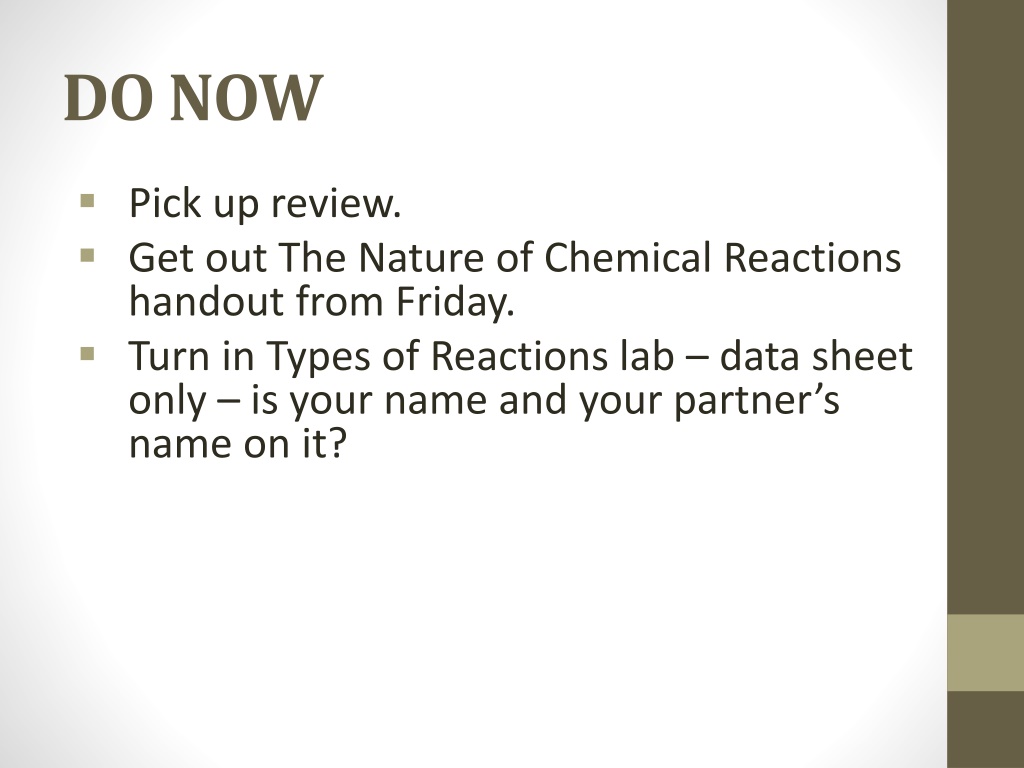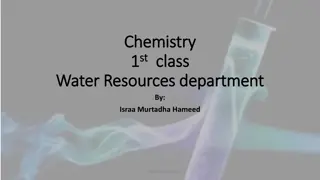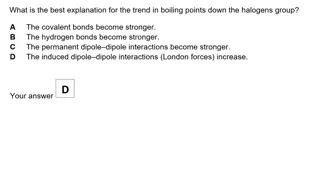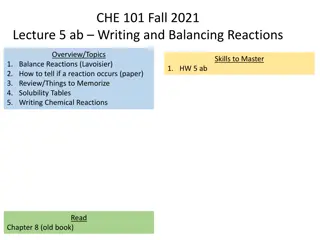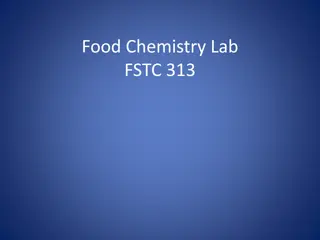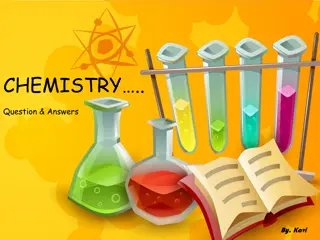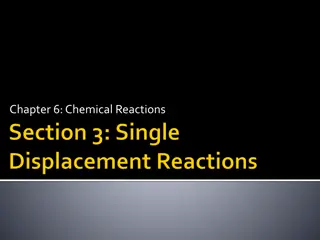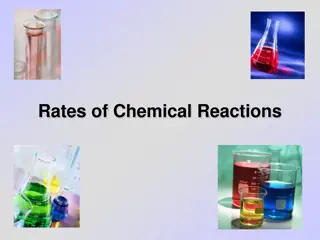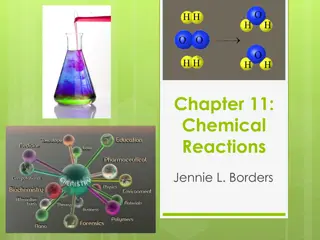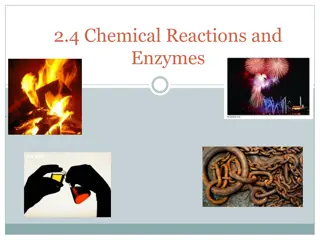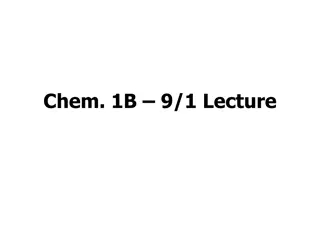Understanding Chemical Reactions in Chemistry Lab
Explore the fascinating world of chemical reactions in the chemistry lab through hands-on experiments and theoretical knowledge. Learn to identify reactants and products, understand the characteristics of chemical reactions, use appropriate symbols in equations, and balance chemical equations effectively. Enhance your understanding of new substances formed, energy changes, activation energy, bonding capacity, and the conservation of mass in various reactions.
Download Presentation

Please find below an Image/Link to download the presentation.
The content on the website is provided AS IS for your information and personal use only. It may not be sold, licensed, or shared on other websites without obtaining consent from the author. Download presentation by click this link. If you encounter any issues during the download, it is possible that the publisher has removed the file from their server.
E N D
Presentation Transcript
DO NOW Pick up review. Get out The Nature of Chemical Reactions handout from Friday. Turn in Types of Reactions lab data sheet only is your name and your partner s name on it?
The Nature of Chemical Reactions D F G C E A B
The Nature of Chemical Reactions 8. In chemistry lab, Ramon adds several granules of zinc to a beaker containing concentrated hydrochloric acid. Bubbles begin to form in the beaker and the zinc begins to disappear. Has a chemical reaction occurred? Explain your answer. Yes, it is a chemical reaction; a new substance was formed. 9. Shelley discovers that the celery in her refrigerator has wilted. She cuts the celery at the base and places the stalks in a tall glass of water overnight. The next morning, the celery stalks are firm again. Has a chemical reaction occurred? Explain your answer. No, it is a physical reaction; it is still celery nothing new was formed.
The Nature of Chemical Reactions Iron (III) phosphate and water Sodium nitrate and calcium hydroxide Calcium carbonate and sodium sulfate CaCl2 + MgO balanced Ca(NO3)2 + H2O Ca(OH)2 + 2HNO3 Ca(NO3)2 + 2H2O ZnS + HCl ZnCl2 + H2S ZnS + 2HCl
The Nature of Chemical Reactions Iron (III) phosphate and hydrogen gas Sodium nitrate and calcium Sodium fluoride and chlorine gas No Reaction, NR LiOH + H2 2Li + 2H2O 2LiOH + H2 No Reaction, NR
TEST REVIEW 1. Identify the reactants and the products in a chemical reaction. Reactants Products
TEST REVIEW 2. Know the five characteristics of a chemical reaction. A. There are always two kinds of substances B. There is always a change in energy in a chemical reaction. C. There is always activation energy D. Bonding Capacity E. Conservation of Mass
TEST REVIEW 3. Use appropriate symbols when writing an equation to accurately describe the chemical reaction. (s) Solid (l) (g) Gas (aq) aqueous liquid
TEST REVIEW 4. Balance a chemical equation. 1. Write the chemical equation for the reaction. 2. Count the number of atoms of each element on both sides of the arrow. 3. Balance the equation using coefficients. Balance metals, then nonmetals, then hydrogen, then oxygen 4. Check your work by recounting the number of atoms on each side of the arrow.
TEST REVIEW 4. Balance a chemical equation. RULES TO FOLLOW Change coefficients only. Never change a symbol, formula, or subscript. Place coefficients in front of the entire chemical formula.
TEST REVIEW 5. Given a written description of a chemical reaction, write a balanced chemical equation using the appropriate symbols and formulas. Write the correct formulas for each of the chemicals named. Determine which are the reactant(s) and which are the product(s). Write out the chemical equation for the reaction. Count the number of atoms of each element on both sides of the arrow. Balance the equation using coefficients Check your work by recounting the number of atoms on each side of the arrow.
TEST REVIEW 6. Classify a reaction as synthesis, decomposition, single replacement, double replacement, or combustion. 1. SYNTHESIS Reaction What to look for: ONE PRODUCT 2Mg(s) + O2(g) 2MgO(s) 2. DECOMPOSITION Reaction What to look for: ONE REACTANT H2CO3(aq) H2O(l) + CO2(g) 3. COMBUSTION What to look for: REACTANT of HYDROCARBON and OXYGEN andPRODUCTS OF CO2 and H2O CH4(g) + 2O2(g) CO2(g) + 2H2O(g)
TEST REVIEW 6. Classify a reaction as synthesis, decomposition, single replacement, double replacement, or combustion. 4. SINGLE REPLACEMENT Reaction What to look for: UNCOMBINED ELEMENT ON EACH SIDE Mg(s) + 2HCl(aq) MgCl2(aq) + H2 Cl2(g) + 2 NaBr(aq) 2NaCl(aq) + Br2(g) 5. DOUBLE REPLACEMENT Reaction (or double displacement reaction) What to look for: TWO COMPOUNDS ON BOTH SIDES HCl(aq) + NaOH(aq) NaCl(aq) + H2O(l)
TEST REVIEW 7. Use the activity series of metals to predict the products of single replacement reactions. 8. Write the products of double-replacement reaction between two ionic compounds.
SCHEDULE TUESDAY: Chemical Reactions Test Chemical Reactions Review is due for test redo points.
SCHEDULE WEDNESDAY - MONDAY: We will start reviewing for your midterm. Wednesday Matter and Measurement Thursday Atom and Periodicity Friday Bonding and Nomenclature Monday Chemical Reactions and final questions
SCHEDULE TUESDAY, December 13: 7th Period: midterm exam 1st, 6th periods: vote on the elements for the periodic table WEDNESDAY, December 14: 1st Period: midterm exam 6th Period: work on your own 7th Period: short answer part of exam.
SCHEDULE THURSDAY: 1st Period: short answer part of exam 6th Period: short answer part of exam 7th Period: vote on the elements for the periodic table FRIDAY: 1st Period: work on your own 6th Period: midterm exam 7th Period: work on your own.
TEST REDOS and COUPONS Test Redo Coupons can be used any time between now and Friday, May 12. Homework or Lab coupons MUST be used before the END of THIS semester. I must receive them by the end of the day, Wednesday, December 14. A listing of labs and homeworks is posted by the class calendar. Please put the HW # or the Lab # on the blank provided on the coupon.
TO DO Work on Chemical Reactions Test Review due tomorrow for test redo points
DO NOW Prepare for test Turn in your Chemical Reactions Review sheet if complete. We will start reviewing for your midterm tomorrow. NO ELECTRONIC DEVICES AT ALL (even music) during the testing time. I will take that device and give it back on Friday afternoon or to your parent, whichever comes first.
CHEMICAL REACTIONS A Review
